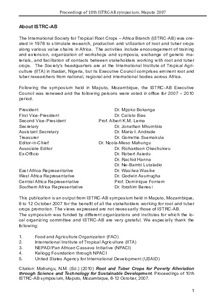| dc.contributor.author | Sandifolo, V.S. |
| dc.contributor.author | Mahungu, N.M. |
| dc.contributor.author | Mkumbira, J. |
| dc.contributor.author | Moyo, C.C. |
| dc.contributor.author | Mhone, A. |
| dc.contributor.author | Benesi, I.R. |
| dc.date.accessioned | 2019-12-04T11:10:58Z |
| dc.date.available | 2019-12-04T11:10:58Z |
| dc.date.issued | 2010 |
| dc.identifier.citation | Sandifolo, V.S., Mahungu, N.M., Mkumbira, J., Moyo, C.C., Mhone, A. & Benesi, I.R. (2010). Effect of cassava leaf harvesting on root yield and quality. In: Proceedings of 10th ISTRC-AB symposium in Mozambique: root and tuber crops for poverty alleviation through science and technology for sustainable development, (p. 168-173), 8-12 October, Maputo. |
| dc.identifier.isbn | 99951-60-00-5 |
| dc.identifier.uri | https://hdl.handle.net/20.500.12478/2318 |
| dc.description.abstract | Cassava leaves are increasingly becoming an important source of nutrition for both human beings and livestock. A study was conducted at Chitedze Research Station, Malawi, to determine the effects of leaf harvesting on root yield and quality from 2003/04 to 2005/06 season. Two cassava varieties were used which included Mbundumali, a sweet variety with low potential for cyanogenic glucosides and widely grown by farmers; and Silira (TMS 60142B) an improved variety which is bitter, originated from IITA in tissue culture form and has high potential for cyanogenic glucosides. The experiment was laid out in a 2 x 3 x 2 factorial design in randomized complete block design replicated three times. Leaves were harvested using two methods of de-topping and ratooning while the leaves from the control were harvested at root harvest. Two fertilizer levels were used of which 92kg N per hectare were applied to some treatments and zero N to the others. Results indicated that leaf harvesting regardless of type of method used reduced cassava root yield, size, and dry matter content significantly (P<0.001). Ratooning method of cassava leaf harvesting produced the highest leaf biomass of about 25.0 tons fresh weight per hectare followed by de-topping (22 tons/ha) and control (9.0 ton/ha). An inverse relationship was observed whereby the more leaves were produced the less the root yield between. Mbundumali variety which has vigorous growth habits produced more leaf biomass and was least affected by leaf harvesting on root yield and dry matter content also. |
| dc.description.sponsorship | United States Agency for International Development |
| dc.format.extent | 168-173 |
| dc.language.iso | en |
| dc.publisher | International Institute of Tropical Agriculture |
| dc.subject | Malawi |
| dc.subject | Cassava Leaf |
| dc.subject | Root Yields |
| dc.subject | Leaf Harvesting |
| dc.title | Effect of cassava leaf harvesting on root yield and quality |
| dc.type | Conference Paper |
| dc.description.version | Peer Review |
| cg.contributor.affiliation | International Institute of Tropical Agriculture |
| cg.contributor.affiliation | Chitedze Agricultural Research Station, Malawi |
| cg.coverage.region | Africa |
| cg.coverage.region | Southern Africa |
| cg.coverage.country | Malawi |
| cg.authorship.types | CGIAR and developing country institute |
| cg.iitasubject | Cassava |
| cg.howpublished | Formally Published |
| cg.publicationplace | Ibadan, Nigeria |
| cg.accessibilitystatus | Limited Access |
| local.dspaceid | 92011 |
| cg.targetaudience | Scientists |

